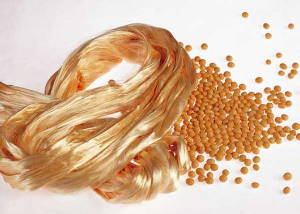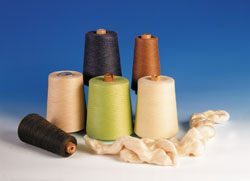
| |||||||||||||||||||||||||||||||||||||||||||||||||||||||||||||||||||||||||||||||||||||||||||||||||||||||||||||||||||||||||||||||||||||||||||||||||||||||||||||||||||||||||||||||||||||||||||||||||||||||||||||||||||||||||||||||||||||||||||||||||||||||||||||||||||||||||||||||||||||||||||||||||
 |
Soybean protein fiber properties
Properties Fabrics from this fiber have the following features: 2. Outstanding comfort: soybean protein fiber not only has
excellent optic effect but also has outstanding features in wearing.
Knitting fabric of soybean protein fiber has soft, smooth and light
handle which is the same as that of fabrics made from silk blended
with cashmere; and the fabric has the same moisture absorption as
that of cotton and better moisture transmission than that of cotton,
which make it comfortable and sanitary. 3. Exceptional dyeing property: the original color of soybean protein fiber is light yellow just like that of tussah silk. It can be dyed by using acid dyestuff and active dyestuff especially the latter that makes the product have fine color and luster, and good sunlight resistance and perspiration fastness as well. Unlike the silk products, soybean protein fiber product resolves the contradiction between fine color and worse color fastness (silk products' sunlight resistance and perspiration fastness are worse which cause easily fading). 4. Good physical property: breaking strength of the single soybean protein fiber is over 3.0cNdtex, which is higher than that of wool, cotton and silk and only lower than that of polyester fiber of high intension. By now, 1.27dtex fiber can be spun into 6dtex yarn with high quality, which can be used for high-quality and high-density fabrics. Because initial modulus of soybean protein fiber is on the high side and boiling water shrinkage is low, fabric size is stable and you will not have to worry about the shrinkage of fabric under natural washing conditions. Also, fabric of soybean protein fiber has outstanding anti-crease, easy-wash and fast-dry property. 5. Healthy and functional property: soybean protein fiber has good affinity to human body's skin and possesses many kinds of amino acid, which makes it to have good health protection effect. Soybean protein fiber filled up the vacancy in textile material development of our country as a big textile-producing country. It will inevitably stimulate the new product development in the field of cotton, wool and spun silk spinning, and bring the textile corporations new development opportunity.
The characteristic of Soybean Protein Fiber fabrics Cashmere feel: The fabric made of Soybean Protein Fiber is soft, smooth, light. It has cashmere feel, but smoother than cashmere; it is as comfortable to the skin as human's second skin. Dry and comfortable: the moisture absorption of bean fiber is similar to that of cotton fiber, but its ventilation is more superior to of cotton. Luxurious appearance: Soybean Protein Fiber fabric has joyful silky luster with perfect drape and elegant; fabrics of yarn in high count has fine and clear texture and is classical shirting. Good color fastness: the original color of soybean protein fiber is ivory like tussah color. It can be dyed by acid dyes and active dyes, especially the color is quite fresh and lustrous with the later dyes while quite stable in the sunshine and perspiration. Compared with silk products, the problem of freshness of color and stability of dying is solved. Its anti-ultraviolet is superior to cotton fiber, much more superior than viscose and silk. Function of Health: Soybean Protein Fiber possesses many amino acids necessary to human's body, so this sole botanic protein fiber has the function of health that no other fiber processes. Meeting people's skin, the amino acid in soybean protein can activate the collagen protein in the skin, resist tickling and evaporate the skin. Bacteria resistant elements are integrated in fiber's molecule chain, which makes the fabrics keep the property of resisting coli bacillus, staphylococcus aureus and candida albicans permanently, this avoids the shortcoming of not permanent effect when the anti-bacteria function is added to the yarn when finishing.
Physical Parameters of SPF
Comparison with Other Fibers
Dyeing Property The dyeing property of soybean knitted fabric with different kinds of dyes were tested and compared, as listed in the table below dyeing property of soybean knitted fabric with different kinds of dyes
Notes: the level is evaluated with five-grade standards: grade 5 is the best and grade 1 is the worst. The test results of the table above indicate that the dyeing property of soybean fiber with neutral dyes is relatively bad (the level is low and penetration property is also bad). Therefore, the application of neutral dyes to soybean fiber must be cautious. The weak-acid dyes, reactive dyes and substantive dyes are suitable for soybean fiber, while due to the low color fastness to washing, the substantive dyes are usually not used to soybean fiber except very few colors. The dying fastness on soybean fiber is similar to wool with different dyes.
Elastic Property The crimp ratio, residual crimp ratio and elastic recovery rate of soybean fiber were tested, as illustrated in the following table
Above table shows that the crimp ratio of soybean fiber is only 1.65%, while the common value of other chemical fiber is 10~15%. Therefore the cohesion force of soybean fiber is rather small and anti-slipping agent is necessary in spinning. The residual crimp ratio is only 0.88%, while the common values of other chemical fibers are 10%, which means that the crimp of soybean fiber is easy to unwind and the crimp stability is poor. The elastic recovery rate of soybean fiber is 55.4%, which is also lower than the common values of other chemical fibers (70~80%). Therefore the elastic property of soybean fiber is poor.
Heat Resistance Property The shrinkage rates of soybean fiber in boiling water and dry heat air are listed below
The test result indicates that the heat shrinkage rate of soybean fiber is rather great, and soybean fiber has no obvious melting point. The fiber strength decreases largely, and the color becomes pale yellow at 160° C; and at 200° C, the color becomes deep yellow; at 300° C, the fiber begins to carbonize, and the color becomes brown. Therefore the temperatures of dyeing and setting of soybean fabric are preferred not to exceed 100° C. If the setting temperature is 110° C, the fabric handle becomes hard. At this time, the fabric handle can only be improved by the washing of soap bath above 60° C.
Light Fastness Property The light fastness of soybean fiber was tested under outdoor condition for two months. After the test, the color of soybean fiber fades a little, the strength decreases 11% and no mold fungus appears. Furthermore, the strength of soybean fiber decreases only 9.8% under the ultraviolet irradiation for 120 hours. The test results indicate that the soybean fiber has good light fastness property and good resistance to ultraviolet radiation, which is better than cotton, viscose and silk.
Antistatic Property The tested electricity parameters of soybean fiber are listed as
The comparison of antistatic property of soybean fiber and other fibers is shown in the following table
It is obvious that the mass specific resistance of soybean fiber is similar with silk, and lower than other man-made fibers. It can be said that the soybean fiber has good antistatic effect, which is beneficial to the textile fabrication and wearing property.
Pilling Property The pilling property of 3 knitted fabric samples, which are made from 32s soybean yarns, 32s cotton yarns and 32s PAN yarns respectively, were tested with nylon brush for 50 revolutions and with fabric for 50 revolutions. The test results indicate that the pilling degree of soybean sample is similar with that of cotton sample and better than that of PAN sample; while the fuzzy fibers of soybean sample are much longer than that of cotton and PAN samples. In a word, due to the low frictional coefficient, low crimp number and low crimp stability of soybean fiber, the soybean fabric sample is easy to fuzz but not easily pilling. According to GB4801.1-84, the pilling property of soybean sample is grade 2, while that of cotton sample is grade 1.5 and PAN sample is grade 1.
Resistance Properties to Alkali, Acid, Moth and Fungus The resistance properties of soybean fiber, wool, silk and cotton were tested and compared, as illustrated below
The table above indicates that the resistance properties to alkali and acid of soybean fiber are the same as those of wool and silk. The resistance to fungus of soybean fiber is also the same as that of wool and silk. And the resistance to moth of soybean fiber is better than that of silk, wool and cotton.
Sanitarian Property and Content of Amino-Acid The soybean protein contains lots of polar amino-acids necessary for human-body, such as hydroxyl, amido-cyanogen and carboxyl. The content of parts of amino-acids is listed below
It is obvious that the soybean fiber has good biocompatibility and is beneficial to the human health. Furthermore, the anti-bacterial agents, which were added to the soybean fiber in spinning process, can restrain the growth of colon bacillus, impetigo bacterial and sporothrix. Therefore, soybean fiber is a kind of sanitarian fiber. Are you interested to see some detailed test reports - please follow this link
| ||||||||||||||||||||||||||||||||||||||||||||||||||||||||||||||||||||||||||||||||||||||||||||||||||||||||||||||||||||||||||||||||||||||||||||||||||||||||||||||||||||||||||||||||||||||||||||||||||||||||||||||||||||||||||||||||||||||||||||||||||||||||||||||||||||||||||||||||||||||||||||||||
| Be notified of page updates |
wwwswicofilcom2015




